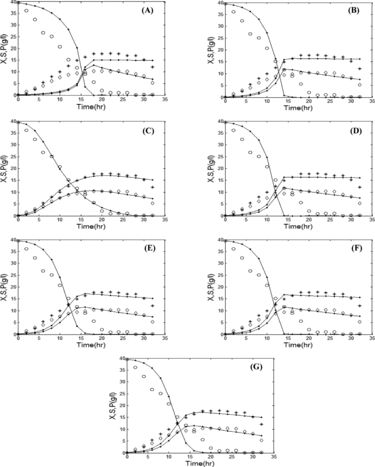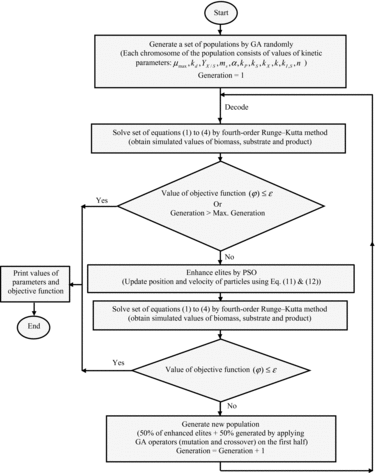Figures & data
Table 1. Growth models considered for the data evaluation.[Citation30–32]
Table 2. Estimated kinetic parameters by hybrid GA/PSO method and value of objective function for various kinetic models.
Figure 4. Comparison of the experimental and simulated data of batch fermentation by various growth kinetic models: Aiba (a), Andrews (b), Contois (c), Haldane (d), Monod (e), Moser (f), and Tessier (g). Experimental concentrations of X (٭), S (○), and P (◊) vs. hybrid GA/PSO simulated data (solid lines). Note: X, biomass (B. licheniformis); S, substrate (glucose); P, product (protease). Initial concentration of substrate is 40 g/L.

Figure 5. Comparison of the experimental and simulated data of fed-batch fermentation by various growth kinetic models: Aiba (a), Andrews (b), Contois (c), Haldane (d), Monod (e), Moser (f), and Tessier (g). Experimental concentrations of X (٭), S (○), and P (◊) vs. hybrid GA/PSO simulated data (solid lines). Note: X, biomass (B. licheniformis); S, substrate (glucose); P, product (protease). Initial concentration of substrate is 40 g/L; feed rate = 0.01 L/h.

Figure 6. Comparison of the experimental and simulated data of batch fermentation by the Contois model by using GA (a) and PSO (b). Experimental concentrations of X (٭), S (○), and P (◊) vs. simulated data (solid lines). Note: X, biomass (B. licheniformis); S, substrate (glucose); P, product (protease). Initial concentration of substrate is 40 g/L.

Figure 7. Comparison of the experimental and simulated data of fed-batch fermentation by the Contois model by using GA (a) and PSO (b). Experimental concentrations of X (٭), S (○), and P (◊) vs. simulated data (solid lines). Note: X, biomass (B. licheniformis); S, substrate (glucose); P, product (protease). Initial concentration of substrate is 40 g/L; feed rate = 0.01 L/h.

Table 3. Comparison of performance across GA, PSO, and hybrid GA/PSO.


